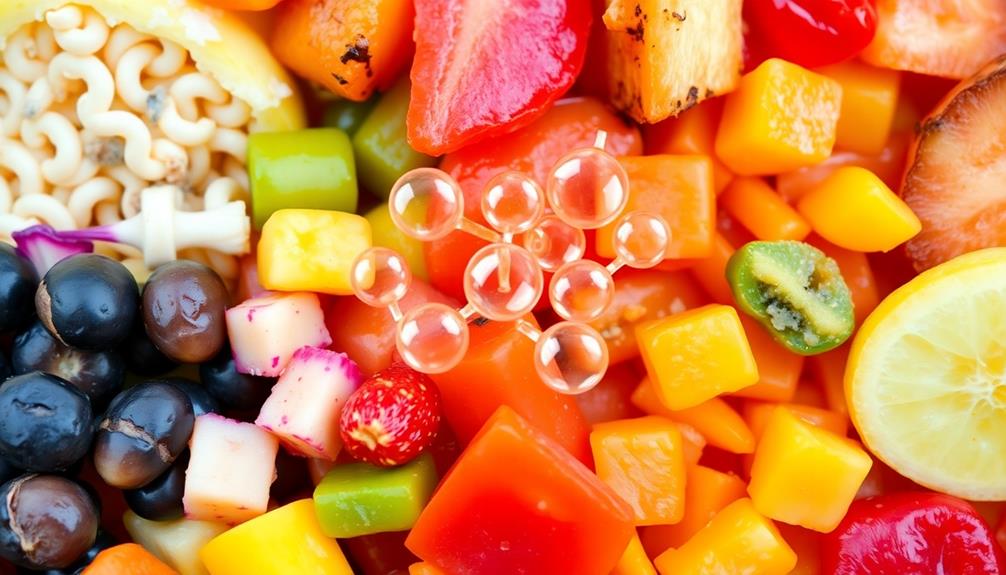Food rituals in esports and gaming play an essential role in enhancing your experience. They boost excitement, focus, and social bonds among teammates. Sharing meals, like finger foods, helps create a communal atmosphere, making everyone feel connected. While gamers often lean towards fast food, these rituals can also foster healthier choices over time. The right food can improve your performance and cognitive function, so choosing nutritious options matters. As you explore this topic, you'll uncover even more fascinating aspects of how food impacts both gameplay and the community around it.
Key Takeaways
- Food rituals enhance the gaming experience by boosting excitement, focus, and team cohesion among players during competitive sessions.
- Sharing meals fosters strong social bonds, creating a sense of belonging and camaraderie within gaming communities.
- Communal dining encourages deeper conversations and strategy discussions, enhancing teamwork and overall performance.
- Seasonal and culturally diverse food choices reflect group dynamics, enriching gaming experiences and fostering unique identities.
- Unhealthy food habits prevalent among gamers can negatively impact cognitive functioning, making awareness and healthier choices crucial for performance.
Importance of Food Rituals

Food rituals play an essential role in enhancing your gaming experience, considerably boosting excitement and focus. When you share meals during gaming sessions, you create a communal atmosphere that strengthens social bonds among you and your teammates.
For example, indulging in dishes like Red-Braised Pork Belly can elevate the experience with its rich flavors. Eating together not only stimulates brainstorming and creativity but also influences the types of food that evoke specific gaming experiences. Most gaming groups find finger foods ideal, allowing for easy sharing while keeping the focus on gameplay.
Your meal preferences can adapt seasonally, reflecting a balance between social engagement and maintaining the gaming flow. Scheduling meals and managing food logistics can considerably impact your gaming sessions; sometimes, it's just easier to eat out to minimize interruptions. This way, you can dive right back into the action, maximizing gameplay time.
Ultimately, shared food experiences help solidify your group identity and culture, creating lasting memories that enhance player camaraderie. The act of sharing food invites connection, fostering a sense of belonging that enriches your overall gaming experience.
Embracing food rituals can transform ordinary gaming nights into unforgettable adventures, where excitement and focus reign supreme.
Community Bonding Through Meals

When you share meals during gaming sessions, you create an environment that fosters connection and camaraderie.
For instance, enjoying a bowl of Nettle and Potato Soup can enhance your gathering with its nutritious blend, making the experience more enjoyable while strengthening the bonds between players.
As you gather around the food, you're not just fueling up; you're building a unique group identity that enhances every gaming moment.
Shared Eating Experiences
Gathering around shared meals during gaming sessions fosters a communal atmosphere that strengthens social bonds among players.
These shared meals not only enhance the gaming experience but also create lasting memories. For instance, sharing a dish like bulgogi can become a highlight of your gaming nights, as everyone enjoys the flavorful marinated beef together.
When you and your friends come together for group meals, often featuring finger foods, it encourages friendship and hospitality while reducing distractions. This way, you can focus on player engagement and immerse yourselves in the game.
Consider the impact of shared meals on your gaming experience:
- Seasonal Food Preferences: Lighter meals in summer, heavier options in winter, reflecting your group's adaptability.
- Rotating Food Provision: Taking turns to bring snacks encourages fairness and fosters fellowship.
- Connection Through Conversations: Out-of-game discussions can seamlessly shift to in-game strategies, deepening your engagement.
- Unique Group Identity: The types of foods shared contribute to your group's distinct character.
- Enhanced Enjoyment: Eating together can elevate the overall fun of your gaming sessions.
Incorporating these elements into your gaming routine not only strengthens social bonds but also enriches the communal atmosphere you share with your fellow players.
Rituals of Togetherness
Shared meals naturally lead to rituals of togetherness, where players bond over the experience of enjoying food while gaming. These communal dining moments enhance community bonding, as the excitement of shared meals boosts enthusiasm among players.
You'll notice that finger foods are often preferred, making it easy to share and enjoy a variety of flavors. Seasonal variations in meal choices, like lighter options in summer and heartier dishes in winter, add a unique touch to each gathering.
Engaging in conversations around the table deepens your connection to both the game and your fellow players, allowing discussions to flow from casual topics to focused in-game strategies seamlessly.
Group meal policies, such as rotating who brings food or having the DM provide meals, promote fairness and encourage participation, enriching the shared experience.
Ultimately, the social dynamics of eating together during gaming sessions reduce distractions and foster camaraderie. These shared food experiences become essential for balancing gaming focus with social interaction, creating lasting memories that strengthen the bonds within your community.
Psychological Benefits of Shared Eating

When you share a meal with your gaming team, it strengthens your social bonds and builds a sense of belonging.
This communal experience not only enhances team cohesion but also creates a more enjoyable atmosphere for everyone involved.
Social Bonding Through Meals
Food plays an essential role in creating connections among gamers, transforming isolated gaming sessions into vibrant social experiences. When you share meals, it fosters camaraderie and enhances social bonds, making your gaming time more enjoyable.
Communal eating encourages deeper conversations, allowing you to shift smoothly from out-of-game discussions to in-game teamwork.
Consider these aspects of shared meals in your gaming experience:
- Increased enthusiasm: Meals boost engagement and excitement during sessions.
- Lasting memories: Enjoying food together creates shared experiences that you'll always remember.
- Adaptable food preferences: Seasonal choices can reflect your group's dynamics, from light summer snacks to hearty winter meals.
- Collaboration in meal prep: Rotating food responsibilities promotes fairness and a sense of community within your group.
- Strengthened identity: Shared meals reinforce your identity as a team, enhancing group cohesion.
Incorporating food rituals into your gaming sessions not only enriches the experience but also cultivates a sense of responsibility and connection, making each moment more meaningful.
Embrace the power of meals to elevate your gaming community!
Enhancing Team Cohesion
Gathering around a meal can greatly enhance team cohesion among gamers. During esports gaming sessions, shared meals foster friendship and hospitality, reducing distractions and promoting a sense of belonging.
This communal atmosphere not only makes gaming more enjoyable but also boosts enthusiasm and engagement within the team's social dynamics.
When you eat together, it paves the way for deeper conversations, helping team members bond over both out-of-game topics and strategic discussions related to gameplay.
These interactions strengthen your collaboration and teamwork, making you more effective as a unit. Integrating food rituals, like rotating meal prep among players, further promotes fairness and reinforces your group's identity within the gaming community.
Food Choices Among Gamers

Over the years, gamers have developed distinct food preferences that often lean towards unhealthy options. You might notice that many of your fellow gamers gravitate towards fast food, energy drinks, and processed snacks.
Studies show that esports players frequently consume an average of 7.5 servings of fast food each month, while their intake of fruits and vegetables barely scratches the surface.
Consider these common food choices among gamers:
- Energy drinks
- Pizza
- Candy
- Burgers
- Chips
The portrayal of gamers as the "Junk Food Gamer" reinforces these unhealthy eating habits, leading to excessive daily energy intake that can exceed 4,500 kcal.
In fact, a significant portion of esports players rely on dietary supplements, particularly caffeine-based ones, to keep their energy levels up during intense gaming sessions. While these choices may enhance the gaming experience, they often don't align with a healthy diet.
Meal times in gaming groups are essential for fostering social bonds.
These shared food rituals contribute to group identity and highlight how gaming behaviors can shape your food choices, sometimes at the expense of your health.
Impact on Performance and Focus

Your food choices directly influence your performance and focus during gaming sessions. Proper food consumption is essential; adequate protein intake boosts cognitive function, enhancing your gameplay. The timing of your meals, especially macronutrients like carbohydrates and fats, can maintain your energy levels and sharpen your focus. Hydration plays a significant role too—dehydration can slow your reaction time and hinder decision-making.
Engaging in communal dining with teammates can create a supportive atmosphere, increasing your enthusiasm and focus. Eating rituals, like sharing finger foods, offer mental resets that can lead to improved performance. Here's a quick look at how different eating habits can impact your gaming experience:
| Eating Habit | Impact on Performance | Emotional Benefit |
|---|---|---|
| Protein-rich meals | Improved cognitive performance | Increased confidence |
| Timely carbohydrate intake | Sustained energy levels | Enhanced motivation |
| Regular hydration | Better reaction times | Reduced stress |
| Communal dining | Strengthened team bonds | Greater enjoyment of gameplay |
| Finger foods | Mental resets during play | Boosted engagement |
Being mindful of your eating habits can transform your gaming experience and elevate your performance.
Cultural Influences on Eating Habits

Cultural influences shape the eating habits of gamers in impactful ways, often reflecting broader societal norms and values. Many gamers find themselves drawn to fast food and energy drinks, a trend perpetuated by the "Junk Food Gamer" stereotype in popular media.
However, there's a shift happening in gaming communities towards healthier eating practices.
- Finnish gamers enjoy seasonal food rituals, favoring lighter meals in summer and heartier options in winter.
- The "Home Food Gamer" narrative emphasizes awareness of healthier choices, contrasting traditional gaming diets.
- Shared meals within gaming groups foster community bonding and create unique food rituals.
- Ethnic backgrounds diversify food choices, with players integrating personal or traditional dishes into their gaming experiences.
- These shared meals enhance group identity and reflect cultural practices.
As you engage with gaming culture, consider how these cultural influences affect your eating habits.
Embracing the diversity of food rituals can lead you towards a more balanced approach, blending enjoyment with healthier eating.
Health Implications of Dietary Trends

While many gamers indulge in fast food and sugary drinks, these dietary trends can have serious health implications, especially for esports players. Your dietary habits play a significant role in maintaining good health and enhancing cognitive performance.
Unfortunately, many esports athletes consume high levels of red and processed meats, along with inadequate nutrient intake, leading to potential health risks. Studies show that esports players often have an average BMI of 25.1 kg/m², highlighting a concerning prevalence of overweight individuals within the gaming community.
Poor dietary choices can negatively impact cognitive functioning, which is essential for competitive gaming. In fact, the majority of esports athletes fail to meet recommended dietary allowances for essential nutrients, which can hinder their overall well-being.
Research indicates that adhering to the Mediterranean diet—rich in fruits, vegetables, whole grains, and healthy fats—can lead to improved health outcomes. Yet, only about 53.7% of esports players in studies from Portugal and Brazil follow this healthier eating pattern.
It's important for you and your fellow gamers to prioritize nutrition to boost cognitive performance and support long-term health.
Future Directions for Research

Exploration of the intricate relationship between food rituals and cognitive performance in esports can pave the way for innovative research directions. Understanding how specific food types and associated rituals impact esports athletes' in-game decision-making is essential.
Here are some areas worth investigating:
- The correlation between nutrient intake and cognitive performance in esports athletes.
- The effects of communal eating during gaming sessions on group dynamics and player engagement.
- Long-term health implications of dietary habits in gaming communities, focusing on obesity and chronic diseases.
- The success of tailored dietary interventions and nutritional education programs for esports players.
- Cultural influences on food choices within global gaming communities and how they shape player experiences.
Frequently Asked Questions
How Does Gaming Affect Eating Habits?
Gaming often leads you to prioritize convenience, triggering unhealthy eating habits like fast food and snacks. Long sessions can disrupt regular meals, making it easy to neglect fruits, vegetables, and proper hydration for quick energy boosts.
What Are the Psychological Effects of Esports?
Imagine your mind as a high-performance engine; neglecting fuel leads to stalling. In esports, insufficient nutrition hampers focus and resilience, while hydration sharpens decision-making, proving that what you eat profoundly impacts your gaming prowess.
What Is the Diet of an Esports Player?
As an esports player, you often rely on fast food, consuming minimal fruits and vegetables. Your diet might lack essential nutrients and hydration, which can negatively impact your cognitive performance and overall gaming ability.
Does Eating Affect Gaming Performance?
Yes, eating affects your gaming performance. Proper nutrition boosts your focus and reaction times, while hydration keeps your cognitive functions sharp. Planning meals wisely can enhance your readiness, ensuring you stay at the top of your game.
Conclusion
In the world of esports and gaming, food rituals aren't just about sustenance; they're about connection, focus, and identity. You share meals to bond, you choose snacks to fuel your gameplay, and you embrace cultural influences to enrich your experience. By understanding these dynamics, you can enhance your performance, deepen your relationships, and cultivate a healthier gaming lifestyle. So, savor the moments, celebrate the meals, and let food be a key player in your gaming journey.









